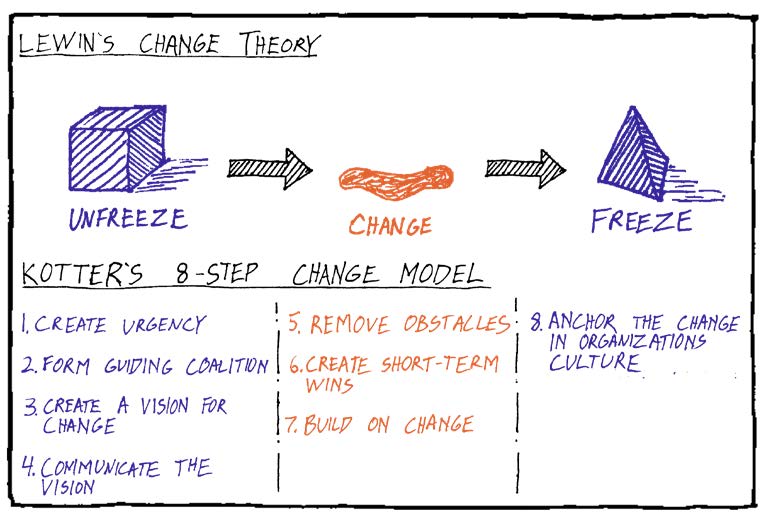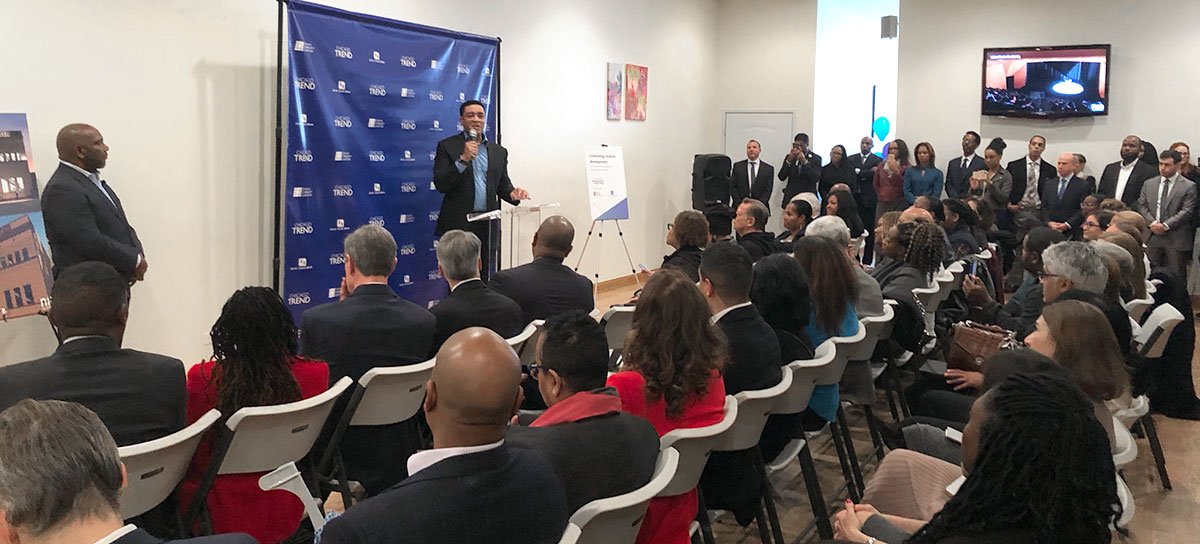Change Management Processes
Utilizing Change Management Processes for Architecture and Returning to Work After the Coronavirus
I started writing a post about change management in early March. At that time, we knew the potentially deadly coronavirus was circulating, but very few of us expected it to upend our daily lives as much as it has. For almost two months, I considered scrapping this post or pushing it back until after we are fully back to work, since change management, as it pertains to architecture, is a low priority to most individuals and organizations at the current time. However, after some consideration, I decided to adjust this post to include how organizations can utilize these same change management principles to return to work and business safely and smoothly in a post-pandemic world.
Humans are creatures of habit and are often resistant to change. Depending on which study you read, between 30% and 50% of people oppose changes at work, even if it will improve the efficiency of their job. These numbers increase or decrease depending on the processes utilized to implement the change. Consequently, change management has become a substantial sector of business management and theory over the past few decades.
In organizations, change can come in the form of a new ERP system, restructuring, or, as we in the architecture industry usually encounter, a new office or facility. Of course, the most significant example on most people’s minds today is the implementation of new social distancing protocols to get organizations back to work. My original intent in this post was to focus on change management as it pertains to new facilities. However, in light of the rapidly changing world around us, I will now also be addressing how management can utilize change management practices to help adjust their companies to a post-pandemic work environment.
There are dozens of change management strategies and approaches, including Lewin’s Change Management Model, Kotter’s Change Management Theory, the McKinsey 7 S Model, and Nudge Theory, just to name a few. For simplicity and clarity, we will focus on the Lewin Model and Kotter’s Theory.

Lewin’s Change Management Model
Kurt Lewin was both a physicist and a social scientist in the 1940s. Lewin used the analogy of taking a cube-shaped block of ice, melting it, and re-freezing it into a differently shaped block of ice to describe the process of change. His three phases are, therefore, ‘unfreeze,’ ‘change,’ and ‘freeze.’ Many change management scholars regard Lewin’s three-step process as the foundational model for change in organizations.
Kotter’s Eight-Step Process
In 1995, Harvard professor Dr. John Kotter introduced his eight-step process in his book Leading Change, which he developed after studying countless leaders and organizations for over two decades. Kotter specifically researched organizations as they were trying to implement new programs and strategies. Through his research, he identified which factors were successful for organizations in effectively implementing change. He then combined these factors to form his eight-step process. Today, Kotter continues to fine-tune his eight-step process, and it is considered the gold standard for change management processes.
While Lewin and Kotter’s processes are different, Kotter’s method is a more detailed and thought out process built upon the foundations of Lewin’s model. I will step through the stages of these models, address how they pertain to new facilities, and address how they can be used to return to a post-pandemic world.

Lewin’s “unfreeze” stage is all about preparing the organization to accept the upcoming change. Leaders must illustrate why the necessary change needs to occur and determine an effective solution to the problem. This stage is all about breaking down the existing organizational status quo or ‘unfreezing the ice cube.’ The ‘unfreeze’ step in Lewin’s process neatly contains the first four steps of Kotter’s eight-step process.
Step 1: Create a Sense of Urgency
Rarely is anything in an organization, or life for that matter, perfect. Furthermore, what may seem like an issue to one person or department may not be evident at all to another. These scenarios are where a sense of urgency is needed. It is useful for someone, usually leadership, to explain to others why the change is problematic and how it is either hurting the organization or limiting its growth. This explanation can be done through an aspirational opportunity statement or through effective communication.
Step 1 for Returning to Work
This spring, the coronavirus pandemic drove most businesses to rapidly shift to remote workforces, rely on PPP loans, and institute social distancing guidelines. While a few organizations had plans in place to address such a scenario, most did not. This missed planning resulted in millions of businesses suddenly, and oftentimes drastically, changing their operations or shutting down altogether. Most employees throughout America had to adjust to working from home almost instantly, dealing with kids being out of school, and other drastic changes to their lives.
State and local governments have already begun rolling out reopening plans, and most businesses have a sense of urgency to get back to work. However, beyond the urgency to get back to work, having plans and processes in place to ensure social distancing is crucial. Over the past decades, many offices have gone away from cubicles and individual offices, instead transitioning to open office plans with shared community areas. These approaches have been great for organizational interaction, but they are proving to be an awful arrangement for preventing the spread of potential viruses. It’ll be crucial for leadership to express the urgency to employees to modify their 2019 office work environments to limit future virus outbreaks in offices.
Step 1 for New Facilities
When it comes to developing a sense of urgency for a new office or facility, managers and owners usually do this by explaining the limitations of the current space or campus. A proper cost-benefit analysis is usually generated to determine the limitations of the existing space in terms of items such as worker productivity in a workplace, recruitment for higher education, or quality of care for healthcare. If a cost-benefit analysis shows the limitations of the organization’s current facility or facilities, it is usually not too difficult to create a sense of urgency for implementing a new architecture or interiors project. This current pandemic may prove to be an opportunity for some businesses to consolidate these issues into one new project.
Tip
A useful tool for assisting the guiding coalition and gaining input from all employees throughout an organization is employee surveys. Through means like SurveyMonkey and SurveyGizmo, organizations can gain valuable incite from their employees while simultaneously giving their employees or users a voice in the decision making process.
Step 2: Create a Guiding Coalition
The larger an organization, the more critical it is to create a guiding coalition. A coalition is a diverse group of people at varying levels within the organization. The more diverse the coalition is, the less likely management will overlook someone’s or some department’s needs. Of course, the larger the group, the more difficult it may be to develop a plan. Finding the right size of a guiding coalition can be a delicate art—however, a conscious effort to develop a diverse coalition is better than nothing.
Step 2 for Returning to Work
In returning to world in a post-pandemic world, a guiding coalition is a useful tool for management. A good manager is always trying to account for all the different scenarios that may affect various employees or departments. However, it is highly unlikely that your company’s managers have ever managed a return to work following a global pandemic. How will social distancing affect different roles? How will employees with high-risk family members feel about returning to “normal” work? What will the company do if employees refuse to comply with new safety precautions? The more of these kind of questions that are asked, the better the organization will be prepared for the return to work.
Step 2 for New Facilities
The guiding coalition for developing a new workplace or facility again requires a diverse range of representatives throughout the organization. Generally, facilities and senior managers are always involved in this process, even if there is no formal change management process. However, the addition of employees from different levels within each department affected by the change is just as crucial in ensuring a new space results in a positive shift in the organization. An effective guiding coalition is comprised of individuals who bring unique experiences to the conversation, which allows the coalition to see all sides of any potential issues and develop possible solutions.
Step 3: Create a Vision for Change
In step three of Kotter’s process, the guiding coalition forms a strategic vision and then develops the initiatives that will be needed to achieve the new vision. By this point, the guiding coalition usually has a good idea of what the overall vision should be, but not always. The initiatives are the individual projects or tasks that are needed to achieve the vision.
Step 3 for Returning to Work
The overall vision for returning to work is something along the lines of “returning to work at the office while assuring our employees, customers, and consultants can remain safe and healthy.” The individual initiatives depend on what the guiding coalition determines needs to be done to get back to work safely. These initiatives could be things like social distancing protocols, increased sanitation stations, or other operational implementations.
Step 3 for New Facilities
In regards to a new facility or space, step three usually involves the programming and concept design phases. Other initiatives may include phasing plans, lease structuring, staffing changes, and other operational changes that arise from creating new facilities or the rehabilitation of existing facilities.
Step 4: Communicating the Vision
Step four was at one time “communicating the vision,” but Kotter recently revised the title of this step to “Enlisting a Volunteer Army.” Both things should occur. I view Phase Four as the moment when you start selling the vision to people not involved in the process up to this point. You may have a great vision and plan, but if you can’t sell the program to gain critical mass, you may encounter serious resistance. Once a vision is established and initiatives are determined, the vision needs to be communicated to everyone to develop what Kotter calls a “volunteer army.”
Constant communication is crucial when the implementation of change is occurring, particularly within an organization. People always talk, and without someone communicating what is happening, rumors can flourish. For this reason, it is almost always crucial to have a point person who is responsible for handling any questions that may arise about the vision.
Step 4 for Returning to Work
Once your guiding coalition has created the vision for reopening, it is essential that you share the vision with everyone on your team and potentially your customers. Many states and municipalities have done a pretty good job of communicating the vision. For example, Illinois shared their Five Phase Reopening Plan. I have also seen numerous restaurants releasing plans for how they will reopen following the shutdown. Questions will likely still arise for people who have individual circumstances such as childcare concerns, family members with pre-existing conditions, or other details that may not be directly addressed in the vision the organization has shared.
Step 4 for New Facilities
Phase Four, in regards to a new architecture or interiors project, is usually the release of the renderings and, potentially, plans to the team and public. This step is when you sell to your team, investors, and clients the magnificent new facility that will improve your organization. It is common for a church or university to use designs to raise funds to achieve the vision. It is also an opportunity for an office to use the renderings to get excited about their new retail center or workplace. It is even common for developers to use the aspects of the design to help convince the public of how their project will enhance the community. The one consistent thing, regardless of the project type, is that you can “enlist a volunteer army” by sharing a project vision that gets people invested in seeing the project succeed.


Change is Lewin’s second phase and includes steps five through seven of Kotter’s eight-step process. Once the organization has “unfrozen” or melted the square ice cube, it is time to remold the water to create the new shape of the organization. In other words, once everyone is on board breaking down the existing structure or status-quo, it is time to execute the change. Throughout the change phases, management must continually communicate to dispel rumors and involve a diverse range of people in the process.
Step 5: Removing Obstacles
Regardless of how well you’ve communicated or sold the vision, there are still some obstacles to overcome. Barriers may be structural, cultural, or psychological. Regardless, the team needs to address them for the new project to move forward.
Note
Step 5 for Returning to Work
For returning to work following the pandemic, various obstacles will exist. Psychologically, it may be hard for some people to return to work with the fear of exposing themselves or their families to the virus. Culturally, it may be hard to get employees to take personal protection or social distancing protocols seriously. Structurally, you may not have enough space to allow all your employees to return and simultaneously remain six feet apart. Regardless of the obstacle, it must be addressed and removed for the project to be successfully implemented.
Step 5 for New Facilities
Many of the barriers that exist on an architectural or interiors project are building code and construction related. This is why it is crucial to have an architecture or interior design firm that is skilled and has a strong understanding of what is required to get a building appropriately designed and approved by the necessary jurisdictions. However, there are almost always other obstacles. How will the company address the vice president who is upset about losing his office because the new space is an open plan layout? How will a developer address the local neighborhood group that is opposed to their project? How will the company respond if a global pandemic severely slows down the economy? The better you address the obstacles, the more likely your project will be implemented successfully.
Step 6: Create Short-Term Wins
For most projects, momentum is critical. To keep the team or the ‘volunteer army’ moving forward, wins early and often ensure the project keeps moving forward. The team should identify the easiest and most-likely successful wins and execute them as early as possible to build up acceleration.
Note
Choose your short-term wins carefully. A failure early can cause people to lose faith in a project and lead to the vision ending before it ever gets moving forward.
Step 6 for Returning to Work
Creating short-term wins is as simple as taking the first step towards a new normal for returning to work following the pandemic. It could simply be having some employees return to the office. It could also be reopening your restaurant for carry-out. It could just be installing hand sanitizing stations in easily accessible locations. The bottom line is that any short-term win will help return things to normal. Of course, because of the specific nature of this pandemic, everything should be done with enough caution that you are not creating additional obstacles. This balance will likely be the most challenging thing for businesses as they venture toward a return to normal..
Step 6 for New Facilities
Short-term wins can be hard for large-scale projects like architecture and interiors projects. There are not many “low-hanging fruit” items for a new building. However, through things like groundbreaking ceremonies, updated renderings, and site tours, you can do your best to keep people excited about the project. For renovation projects, this is often as simple as completing the most uncomplicated phase of the project first, assuming it doesn’t complicate things logistically or make permitting more difficult.
Some easily accessible short-term wins for architecture projects are:
- Releasing Updated Renderings or Plans
- Involving Staff with Furniture Selection
- Ground-Breaking Ceremonies
- Site Tours
- Releasing a New Website for the Project
Step 7: Build on Change
Once you generate momentum from the short-term wins, you have to utilize the early successes and continue making progress towards the vision. The momentum and credibility gained build your good-will for the more complicated processes and items.
Step 7 for Returning to Work
Once you begin slowly reopening your organization, each new step back toward “normal” (or at least a “new normal”) is a win. However, in this instance, be cautious. Should a person become infected in the office, you will likely need to restart the whole process over, but with less trust from your employees and possibly from your customers.
Step 7 for New Facilities
Because there are limited “short-term wins,” This step usually includes both the most stressful and most enjoyable times of an architecture project. As construction documents are nearing completion, everyone involved in the project from the client to the architect feels like they have been devoting a ton of time and energy towards something that is not getting completed fast enough. For this reason, the more short-term wins you can generate, the easier it is to keep your ‘volunteer army’ motivated. As construction nears completion, though, the frustration quickly turns to excitement in anticipation of the new building or space.

Step 8: Anchor the Change in the Organization’s Culture
The last phase of Lewin’s model is the “freeze.” Once you have reshaped the water into its new form, you need to “freeze” it to create the new normal. The steps for both Lewin and Kotter’s approaches are pretty much identical for this last step. For both, management needs to anchor the changes into the organization. The final phase can vary drastically depending on the type of project, but the underlying consistency is that you establish new protocols to ensure the organization does not regress to the pre-project normal.
Step 8 for Returning to Work
For returning to work post-coronavirus, this steop is yet to be determined. There are no shortage of writings speculating what this pandemic will mean for the open office or the future of education and retail. Perhaps, once a vaccine is created, most organizations will return to the workplace of 2019. However, until there is such a vaccine, or we reach herd immunity, the “new normal” will likely be an increase in social distancing for all of our businesses. That means this new normal will need to become the norm. As such, organizations will need to develop new standard operating procedures to replace pre-coronavirus pandemic habits.
Step 8 for New Facilities
The last step for a new facility or office is often easier than many other operational changes. After all, it is unlikely someone is going to keep going to the old office or old business even though the company is no longer there. However, some new habits need to be established. If the new facility has new sustainability features, facilities staff will need to ensure they are running the building correctly. Or, if the space planner designs a new office to be hotel-style seating instead of assigned seating, standard operations will need to be implemented to ensure the company avoids reverting the new space to the same manner of the previous office.
The only constant is change.
As mentioned in the beginning of this post, the original intent of this piece was to solely address change management from a building and facility perspective. However, it seemed appropriate to modify it to show processes that can help companies reemerge from the coronavirus pandemic successfully.
So far, 2020 has been a year of adapting to change. Unfortunately, much of this change was very sudden and difficult to plan for, and these drastic changes have had severe implications on our economies, businesses, and personal lives. While we had little ability to prepare for the changes that resulted from the coronavirus, we can do our best to ensure we properly plan as we our new normal.
These change management processes from Lewin and Kotter will help ensure you successfully implement your goals, whether they be for returning to work, implementing a facility, or any other purpose.
About Author

Brad Riemann
Director of Marketing
Brad is responsible for the Nia Architect’s marketing and business development while simultaneously designing various architectural projects. Brad has business and marketing experience in real estate, manufacturing, and other industries. This experience, combined with his architecture background, gives him a unique understanding of the juxtaposition of design and business.
Related Posts
Interview with Nia Designer and Associate Principal Pierre Moulinier
Interview with Pierre Moulinier An interview with Nia Architects' Designer and Associate Principal Pierre Moulinier Pierre, other than Anthony, you have easily been Nia's longest-standing team member. Could you give me a quick overview of your history with Nia, and...
Achieving Innovation in Architecture Through Diversity
Value of Diversity Achieving Innovation in Architecture Through DiversityArchitects love to talk about innovation. It is a word that you regularly see in the majority of firms out there. It is what architecture awards frequently look for, and it is often one of the...
Welcome to Nia’s new website and blog!
Welcome to Nia's new website and blog! Nia has brought their architectural design and technical expertise to dozens of projects over the past twenty years. The firm has developed an excellent reputation for high-quality projects on residential, mixed-use, healthcare,...



